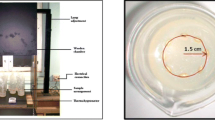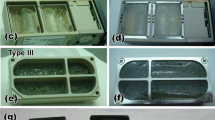Abstract
The role of nitric oxide (NO) in the response of plants to simulated microgravity has been studied. It was found that treatment of Arabidopsis thaliana seeds with NO donor sodium nitroprusside (SNP), stimulating changes in root growth parameters, leads to increased plant resistance to clinostating. After treatment of seeds with SNP, the content of endogenous NO in control plants on the sixth day of cultivation increased by 1.5 times, and it increased by 1.8 times in clinostated seed. The content of endogenous NO gradually decreased on days 9–12, which may indicate the adaptation of plants to the clinostating conditions. Using a specific DAF-FM DA fluorescent probe, an increase in NO fluorescence was found in epidermal cells of root apexes and root hairs in clinostated plants, indicating the accumulation of endogenous NO in these root tissues under stress. On the sixth day of cultivation under clinostat conditions compared with control plants, there was an increase in the accumulation of autophagosomes in the epidermal cells of the transitional zone of the root with the following decrease in this indicator on days 9–12. Seed treatment with cPTIO (NO scavenger) slightly inhibited seedling growth, and this effect was enhanced under clinostating, including a significant increase in the accumulation of autophagosomes in epidermal cells. Thus, the data obtained indicate that the regulation of endogenous NO content is an important component of intracellular signaling mechanisms that are involved in the response of plant cells to simulated microgravity.





Similar content being viewed by others
REFERENCES
Bassham, D.C., Laporte, M., Marty, F., et al., Autophagy in development and stress responses of plants, Autophagy, 2006, vol. 2, pp. 2–11. https://doi.org/10.4161/auto.2092
Beckman, J.S., Chen, J., Ischiropoulos, H., and Crow, J.P., Oxidative chemistry of peroxynitrite, Methods Enzymol., 1994, vol. 233, pp. 229–240. https://doi.org/10.1016/s0076-6879(94)33026-3
Blume, Y.B., Krasylenko, Y.A., Demchuk, O.M., and Yemets, A.I., Tubulin tyrosine nitration regulates microtubule organization in plant cells, Front. Plant Sci., 2013, vol. 4, art. ID 530. https://doi.org/10.3389/fpls.2013.00530
Cao, J.-J., Liu, C.-X., Shao, S.-J., and Zhou, J., Molecular mechanisms of autophagy regulation in plants and their applications in agriculture, Front. Plant Sci., 2021, vol. 11, art. ID 618944. https://doi.org/10.3389/fpls.2020.618944
Cao, Y., Fan, X., Shen, Z., et al., Nitric oxide affects preimplantation embryonic development in a rotating wall vessel bioreactor simulating microgravity, Cell Biol. Int., 2007, vol. 31, no. 1, pp. 24–29. https://doi.org/10.1016/j.cellbi.2006.09.003
Cassia, R., Amenta, M., Fernández, M.B., et al., The role of nitric oxide in the antioxidant defense of plants exposed to UV-B radiation, in Reactive Oxygen, Nitrogen and Sulfur Species in Plants, Hasanuzzaman, M., Fotopoulos, V., Nahar, K., and Fujita, M., Eds., Wiley, 2019, pp. 555–572.
Chen, H., Dong, J., and Wang, T., Autophagy in plant abiotic stress management, Int. J. Mol. Sci., 2021, vol. 22, no. 8, art. ID 4075. https://doi.org/10.3390/ijms22084075
Correa Aragunde, M.N., Foresi, N.P., and Lamattina, L., Nitric oxide is a ubiquitous signal for maintaining redox balance in plant cells: regulation of ascorbate peroxidase as a case study, J. Exp. Bot., 2015, vol. 66, no. 10, pp. 2913–2921. https://doi.org/10.1093/jxb/erv073
Correll, M.J., Pyle, T.P., Millar, K.D.L., et al., Transcriptome analyses of Arabidopsis thaliana seedlings grown in space: implications for gravity-responsive genes, Planta, 2013, vol. 238, pp. 519–533. https://doi.org/10.1007/s00425-013-1909-x
de Angeli, A., Thomine, S., Frachisse, J-M., et al., Anion channels and transporters in plant cell membranes, FEBS Lett., 2007, vol. 581, no. 12, pp. 2367–2374. https://doi.org/10.1016/j.febslet.2007.04.003
Fancy, N.N., Bahlmann, A-K., and Loake, G.J., Nitric oxide function in plant abiotic stress, Plant, Cell Environ., 2017, vol. 40, pp. 462–472. https://doi.org/10.1111/pce.12707
Gilroy, S., Białasek, M., Suzuki, N., et al., ROS, calcium, and electric signals: key mediators of rapid systemic signaling in plants, Plant Physiol., 2016, vol. 171, no. 3, pp. 1606–1615. https://doi.org/10.1104/pp.16.00434
Hu, X., Neill, S.J., Tang, Z., and Cai, W., Nitric oxide mediates gravitropic bending in soybean roots, Plant Physiol., 2005, vol. 137, no. 2, pp. 663–670. https://doi.org/10.1104/pp.104.054494
Khan, M., Al Azawi, T.N.I., Pande, A., et al., The role of nitric oxide-induced ATILL6 in growth and disease resistance in Arabidopsis thaliana, Front. Plant Sci., 2021, vol. 12, art. ID 685156. https://doi.org/10.3389/fpls.2021.685156
Klein-Nulend, J., Bacabac, R.G., Veldhuijzen, J.P., Van Loon, J.J.W.A., Microgravity and bone cell mechanosensitivity, Adv. Space Res., 2003, vol. 32, no. 8, pp. 1551–1559. https://doi.org/10.1016/S0273-1177(03)90395-4
Krasylenko, Yu.A., Yemets, A.I., Sheremet, Ya.A., and Blume, Ya.B., Nitric oxide as a critical factor for Arabidopsis microtubules perceptions of UV-B irradiation, Physiol. Plant, 2012, vol. 145, no. 4, pp. 505–515. https://doi.org/10.1111/j.1399-3054.2011.01530.x
Krasylenko, Yu.A., Yemets, A.I., and Blume, Ya.B., Cell mechanisms of nitric oxide signaling in plants under abiotic stress conditions, in Mechanism of Plant Hormone Signaling Under Stress: A Functional Genomic Frontier, Pandey, G., Ed., Wiley-Blackwell, 2017, vol. 1, pp. 371–398. https://doi.org/10.1002/9781118889022.ch15
Kruse, C.P.S. and Wyatt, S.E., Nitric oxide, gravity response, and a unified schematic of plant signaling, Plant Sci., 2022, vol. 314, art. ID 111105. https://doi.org/10.1016/j.plantsci.2021.111105
Lin. J. and Wang, L., Oxidative stress in oocytes and embryo development: implications for in vitro systems, Antioxid. Redox Signaling, 2021, vol. 34, no. 17, pp. 1394–1406. https://doi.org/10.1089/ars.2020.8209
Lytvyn, D.I., Raynaud, C., Yemets, A.I., et al., Involvement of inositol biosynthesis and nitric oxide in the mediation of UV-B induced oxidative stress, Front. Plant Sci., 2016, vol. 7, art. ID 430. https://doi.org/10.3389/fpls.2016.00430
Lytvyn, D.I., Olenieva, V.D., Yemets, A.I., and Blume, Ya.B., Histochemical analysis of tissue-specific α-tubulin acetylation as a response to autophagy induction by different stress factors in Arabidopsis thaliana, Cytol. Genet., 2018, vol. 52, pp. 245–252. https://doi.org/10.3103/S0095452718040059
Mohd Amnan, M.A., Pua, T.-L., Lau, S.-E., et al., Osmotic stress in banana is relieved by exogenous nitric oxide, PeerJ, 2021, vol. 9, art. ID e10879. https://doi.org/10.7717/peerj.10879
Mugnai, S., Pandolfi, C., Masi, E., et al., Oxidative stress and NO signalling in the root apex as an early response to changes in gravity conditions, BioMed. Res. Int., 2014, vol. 2014, art. ID 834134. https://doi.org/10.1155/2014/834134
Mur, L.A.J., Mandon, J., Persijn, S., et al., Nitric oxide in plants: an assessment of the current state of knowledge, AoB Plants, 2013, vol. 5, art. ID pls052. https://doi.org/10.1093/aobpla/pls052
Nasir, N.N.M., Ho, C.-L., Lamasudin, D.U., and Saidi, N.B., Nitric oxide improves tolerance to Fusarium oxysporum f. sp. cubense Tropical Race 4 in banana, Physiol. Mol. Plant Pathol., 2020, vol. 111, art. ID 101503. https://doi.org/10.1016/j.pmpp.2020.101503
Olenieva, V., Lytvyn, D., Yemets, A., et al., Tubulin acetylation accompanies autophagy development induced by different abiotic stimuli in Arabidopsis thaliana, Cell Biol. Int., 2019, vol. 43, no. 9, pp. 1056–1064. https://doi.org/10.1002/cbin.10843
París, R., Vazquez, M.M., Graziano, M., et al., Distribution of endogenous NO regulates early gravitropic response and PIN2 localization in Arabidopsis roots, Front. Plant Sci., 2018, vol. 9, art. ID 495. https://doi.org/10.3389/fpls.2018.00495
Paul, A.-L., Zupanska, A.K., Schultz, E.R., and Ferl, R.J., Organ-specific remodeling of the Arabidopsis transcriptome in response to spaceflight, BMC Plant Biol., 2013, vol. 13, art. ID 112. https://doi.org/10.1186/1471-2229-13-112
Pedroso, M.C. and Durzan, D.J., Effect of different gravity environments on DNA fragmentation and cell death in Kalanchoë leaves, Ann. Bot., 2000, vol. 86, no. 5, pp. 983–994. https://doi.org/10.1006/anbo.2000.1260
Plohovska, S.H., Krasylenko, Y.A., and Yemets, A.I., Nitric oxide modulates actin filament organization in Arabidopsis thaliana primary root cells at low temperatures, Cell Biol. Int., 2019, vol. 43, no. 9, pp. 1020–1030. https://doi.org/10.1002/cbin.10931
Rizzo, A.M., Montorfano, G., Negroni, M., et al., Simulated microgravity induce glutathione antioxidant pathwayin Xenopus laevis embryos, Cell Biol. Int., 2009, vol. 33, no. 8, pp. 893–898. https://doi.org/10.1016/j.cellbi.2009.04.015
Sarath, G., Bethke, P.C., Jones, R., et al., Nitric oxide accelerates seed germination in warm-season grasses, Planta, 2006, vol. 223, pp. 1154–1164. https://doi.org/10.1007/s00425-005-0162-3
Siamwala, J.H., Reddy, S.H., Majumder, S., et al., Simulated microgravity perturbs actin polymerization to promote nitric oxide-associated migration in human immortalized Eahy926 cells, Protoplasma, 2010, vol. 242, pp. 3–12. https://doi.org/10.1007/s00709-010-0114-z
Strohm, A., Baldwin, K., and Masson, P., Multiple roles for membrane-associated protein trafficking and signaling in gravitropism, Front. Plant Sci., 2012, vol. 3, art. ID 274. https://doi.org/10.3389/fpls.2012.00274
Sun, H., Feng, F., Liu, J., and Zhao, Q., Nitric oxide affects rice root growth by regulating auxin transport under nitrate supply, Front. Plant Sci., 2018, vol. 9, art. ID 659. https://doi.org/10.3389/fpls.2018.00659
Wang, Z., Ma, R., Zhao, M., et al., NO and ABA Interaction regulates tuber dormancy and sprouting in potato, Front. Plant Sci., 2020, vol. 11, art. ID 311. https://doi.org/10.3389/fpls.2020.00311
Xiao, Y., Liu, Y., and Wang, G., Involvement of nitric oxide in the mechanism of biochemical alterations induced by simulated microgravity in Microcystis aeruginosa, Adv. Space Res., 2012, vol. 49, no. 5, pp. 850–858. https://doi.org/10.1016/j.asr.2011.11.003
Xiong, J., Li, Y., and Nie, J., Effects of simulated microgravity on nitric oxide level in cardiac myocytes and its mechanism, Sci. China, Ser. C: Life Sci., 2003, vol. 46, no. 3, pp. 302–309. https://doi.org/10.1360/03yc9032
Yemets, A.I., Krasylenko, Yu.A., and Blume, Ya.B., Nitric oxide and UV-B radiation, in Nitric Oxide Action in Abiotic Stress Responses in Plants, Khan, M.N., Mobin, M., Mohammad, F., and Corpas, F.J., Eds., Springer-Verlag, 2015, pp. 141–154. https://doi.org/10.1007/978-3-319-17804-2_9
Yemets, A., Shadrina, R., Horyunova, I., et al., Development of autophagy in plant cells under microgravity: the role of microtubules and atg8 proteins in autophagosome formation, in Space Research in Ukraine 2018–2020, Fedorov, O., Ed., Akademperiodyka, 2021, pp. 79–84.
Yun, B.-W., Feechan, A., Yin, M., et al., S-nitrosylation of NADPH oxidase regulates cell death in plant immunity, Nature, 2011, vol. 478, no. 7368, pp. 264–268. https://doi.org/10.1038/nature10427
Yun, B.-W., Skelly, M.J., Yin, M., et al., Nitric oxide and S‑nitrosoglutathione function additively during plant immunity, New Phytol., 2016, vol. 211, no. 2, pp. 516–526. https://doi.org/10.1111/nph.13903
Zhan, N., Wang, C., Chen, L., et al., S-nitrosylation targets GSNO reductase for selective autophagy during hypoxia responses in plants, Mol. Cell, 2018, vol. 71, no. 1, pp. 142–154. https://doi.org/10.1016/j.molcel.2018.05.024
Zhang, Y., Su, J., Cheng, D., et al., Nitric oxide contributes to methane-induced osmotic stress tolerance in mung bean, BMC Plant Biol., 2018, vol. 18, art. ID 207. https://doi.org/10.1186/s12870-018-1426-y
Shadrina, R.Y., Yemets, A.I., and Blume, Ya.B., Autophagy development as an adaptive response to microgravity conditions in Arabidopsis thaliana, Factors Exp. Evol. Organisms, 2019, vol. 25, pp. 327–332. https://doi.org/10.7124/FEEO.v25.1186
Shadrina, R.Y., Horiunova, I.I., Blume, Ya.B., and Yemets, A.I., Autophagosome formation and transcriptional activity of atg8 genes in Arabidopsis root cells during the development of autophagy under microgravity conditions, Rep. Nat. Akad. Nauk Ukr., 2020, vol. 9, pp. 77–85. https://doi.org/10.15407/dopovidi2020.09.077
ACKNOWLEDGMENTS
This research has been financially supported by the project “Development of the concept of regulation of development and stress resistance of plants for their adaptation to space flight conditions by attracting cellular and biological resources” of the targeted comprehensive program of the National Academy of Sciences of Ukraine for scientific space research for 2018–2022 (state registration number 01118U003742).
Funding
This study did not receive any certain grant from financial organs in governmental, commercial, or noncommercial sectors.
Author information
Authors and Affiliations
Corresponding author
Ethics declarations
The authors declare that they have no conflicts of interest. This article does not contain any studies involving animals or human participants performed by any of the authors.
Additional information
Translated by V. Mittova
About this article
Cite this article
Plokhovska, S.H., Shadrina, R.Y., Kravets, O.A. et al. The Role of Nitric Oxide in the Arabidopsis thaliana Response to Simulated Microgravity and the Involvement of Autophagy in This Process. Cytol. Genet. 56, 244–252 (2022). https://doi.org/10.3103/S0095452722030100
Received:
Revised:
Accepted:
Published:
Issue Date:
DOI: https://doi.org/10.3103/S0095452722030100




